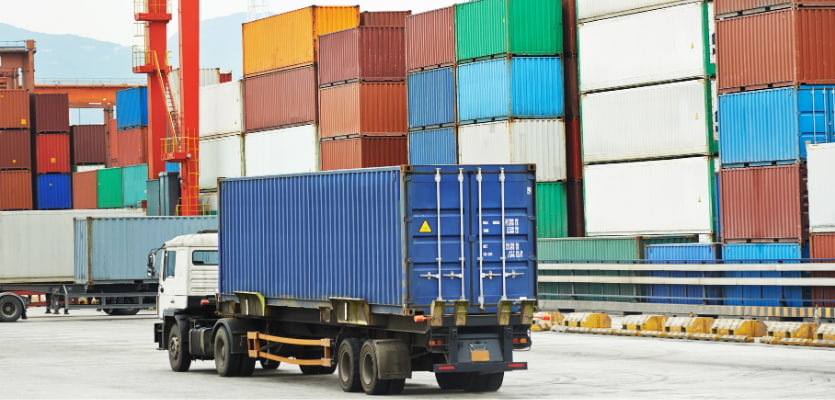In the evolving landscape of logistics and supply chain management, intermodal freight shipping has emerged as a game-changer for businesses aiming to optimize efficiency, reduce costs, and enhance sustainability. As companies grapple with complex shipping demands across vast geographies, understanding the fundamentals and advanced features of intermodal freight shipping is essential for making informed decisions in 2025.
At its core, intermodal freight shipping refers to the transportation of goods using multiple modes of transport—typically a combination of rail, truck, and sometimes ocean or air freight—without handling the freight itself when changing modes. This seamless movement of containers between transportation methods offers a unique set of features, benefits, and challenges that shippers must grasp to capitalize on this logistics solution effectively.
What is Intermodal Freight Shipping?
Intermodal freight shipping integrates the strengths of various transport modes to deliver cargo efficiently and cost-effectively. Typically, containers are loaded onto trucks for local pickup and delivery, moved across long distances by rail or ocean freight, and transferred between these modes without unloading the contents. This approach contrasts with traditional trucking, where goods are handled multiple times, increasing the risk of damage and delays.
The rising popularity of intermodal freight shipping stems from its ability to combine the flexibility of trucks with the long-haul efficiency of rail and ocean carriers. In 2025, intermodal solutions are increasingly supported by technology and infrastructure improvements, making it easier for shippers to navigate the complexities of multi-modal transport.
Why Intermodal Freight Shipping Matters in 2025
In 2025, supply chains face unprecedented challenges: fluctuating fuel prices, labor shortages, stricter environmental regulations, and increasing customer expectations for faster and reliable deliveries. Against this backdrop, intermodal freight shipping offers shippers a strategic advantage by providing cost savings, environmental benefits, and enhanced capacity.
Rising fuel costs and carbon emissions targets are pushing companies to seek greener alternatives. Rail freight, a core component of intermodal shipping, emits significantly fewer greenhouse gases per ton-mile compared to trucks. This makes intermodal freight shipping a sustainable choice that aligns with global and Canadian environmental goals.
Moreover, congestion on highways and urban centers creates delays and unpredictability for truck-only shipments. Intermodal freight shipping mitigates this by shifting long-haul segments to rail or water, freeing up road capacity and reducing transit times overall.
Key Features of Intermodal Freight Shipping
- Containerization: One of the defining features of intermodal freight shipping is the use of standardized containers that can be easily transferred across trucks, trains, and ships without unpacking. This drastically reduces cargo handling and improves security and efficiency.
- Multi-Modal Integration: The core strength lies in combining multiple transportation modes seamlessly, allowing shippers to optimize routes based on cost, speed, and service reliability.
- Infrastructure Support: In 2025, enhanced terminal facilities, intermodal yards, and container handling technology contribute to smoother transfers and reduced dwell times.
- Technology-Driven Visibility: Advanced tracking and freight management systems give shippers real-time insight into cargo location and status, enabling proactive issue resolution.
The Benefits of Intermodal Freight Shipping
Choosing intermodal freight shipping offers numerous advantages:
- Cost Efficiency: Rail transport is more fuel-efficient and less expensive over long distances than trucking, making intermodal a cost-saving choice for many shipments.
- Environmental Sustainability: With stricter regulations on emissions, intermodal shipping’s reduced carbon footprint is a key benefit.
- Reliability and Capacity: Rail networks can handle larger volumes, reducing risks of delays from highway congestion or driver shortages.
- Security: Reduced cargo handling means lower risk of theft and damage.
- Flexibility: The ability to combine different modes allows for tailored logistics solutions that fit unique shipping needs.
Challenges in Intermodal Freight Shipping
Despite its many benefits, intermodal freight shipping comes with challenges that require attention:
- First and Last Mile Logistics: Efficient trucking connections are critical to ensure cargo moves smoothly to and from rail or port terminals.
- Infrastructure Limitations: Not all regions have well-developed intermodal facilities, which can limit route options.
- Complex Coordination: Managing schedules and handoffs between multiple carriers and modes requires robust planning and communication.
- Regulatory Compliance: Cross-border shipments using intermodal require adherence to various customs and safety regulations.
Why You Need to Know About Intermodal Freight Shipping in 2025
As global trade and e-commerce volumes grow, logistics providers and shippers must stay informed about intermodal freight shipping trends and innovations. Understanding the key features, benefits, and challenges helps companies adapt their supply chain strategies for better resilience and cost management.
In Canada, where distances are vast and diverse climates pose shipping risks, intermodal freight shipping is especially valuable. It supports economic hubs in cities like Toronto, Vancouver, and Montreal by enabling efficient connections to ports and distribution centers.
How to Leverage Intermodal Freight Shipping for Your Business
In 2025, shippers looking to maximize the benefits of intermodal freight shipping should consider:
- Partnering with experienced logistics providers who specialize in intermodal solutions.
- Using technology platforms that provide shipment visibility and data analytics for smarter decision-making.
- Evaluating routes that combine rail and truck transport to balance cost and delivery speed.
- Planning shipments in advance to secure capacity and avoid surcharges.
By mastering these aspects, companies can reduce freight costs, minimize environmental impact, and improve overall shipping reliability.
Understanding intermodal freight shipping is essential for any business involved in large-scale freight movement in 2025. Its unique combination of containerization, multi-modal transport, and technological advancements delivers significant cost savings, environmental benefits, and operational efficiency.
While challenges such as first/last mile logistics and infrastructure gaps exist, they can be managed through strategic planning and expert partnerships. For businesses shipping across Canada and internationally, embracing intermodal freight shipping is a smart step toward building a future-proof supply chain.
In the following sections, we will explore 10 powerful features, benefits, and challenges of intermodal freight shipping that every shipper should know to navigate this dynamic logistics solution successfully.

What is Intermodal Freight Shipping?
Intermodal freight shipping is the movement of goods using multiple transportation modes—such as trucks, trains, ships, or planes—without unloading the cargo when switching between modes. This method relies on standardized containers, which enable smooth transfers between different transport types, reducing delays and damage risks.
By combining the strengths of various transportation modes, intermodal shipping provides a cost-effective, efficient, and secure way to move goods over long distances, from the point of origin to the final destination.
Key Features of Intermodal Freight Shipping
Intermodal freight shipping is built on a foundation of efficiency, security, and sustainability. By leveraging the unique advantages of different transportation modes, it streamlines the movement of goods across vast distances while minimizing costs and environmental impact.
Below are the standout features that make intermodal shipping an essential part of modern logistics:
- Standardized Containers: Intermodal shipping uses universally designed containers that are compatible with trucks, trains, ships, and planes, ensuring seamless transitions without the need to unload or repack goods.
- Efficient Mode Integration: This method combines the strengths of various transportation modes, such as the flexibility of trucking, the cost-effectiveness of rail, and the global reach of maritime shipping.
- Reduced Cargo Handling: Containers remain sealed throughout their journey, minimizing the handling of goods, which reduces the risk of damage, theft, and contamination.
- Cost Savings: By leveraging rail and maritime transport for long distances, businesses benefit from lower fuel, labor, and operational costs.
- Eco-Friendly Logistics: Intermodal shipping supports sustainability by reducing greenhouse gas emissions, especially when rail and maritime modes are prioritized over trucking and air freight.
- Enhanced Security: Sealed containers ensure goods are protected from tampering and weather-related damage, offering peace of mind to shippers and clients alike.
- Global Connectivity: Intermodal shipping bridges domestic and international logistics, making it possible to move goods seamlessly across countries and continents.
- Scalability and Flexibility: It accommodates a wide range of shipment sizes, from small parcels to bulk goods, making it adaptable for businesses of any scale.
- Infrastructure Support: The process depends on specialized infrastructure, including ports, rail terminals, and storage yards, which are designed for high efficiency and swift container transfers.
- Real-Time Tracking and Coordination: Advanced logistics technologies, such as GPS and automated systems, ensure precise tracking and coordination across all modes of transportation.
How Intermodal Freight Shipping Works
Intermodal freight shipping is an efficient method of transporting goods by combining multiple modes of transport, such as trucks, trains, and ships, without physically handling the cargo when switching between modes. The process relies on standardized containers and a well-coordinated transfer system to ensure seamless operations.
The Transportation Modes Involved
Intermodal shipping uses different modes of transportation to leverage their individual strengths, creating a cost-effective and efficient process:
- Trucking: Trucks handle the first and last leg of the journey, known as the “first mile” and “last mile.” They transport containers from factories, warehouses, or distribution centers to rail terminals or ports and then deliver them from the final terminal to their destination.
- Rail: Trains are ideal for moving large quantities of goods over long distances. They are more fuel-efficient than trucks, making them a cost-effective and eco-friendly option for inland transportation.
- Maritime Shipping: Ships are essential for international trade, carrying containers across oceans. Ports act as central hubs where containers are loaded onto or off ships for further transport.
- Air Freight: Though less common due to high costs, planes are sometimes used for high-value or time-sensitive goods requiring rapid delivery.
The Step-by-Step Process
- Container Loading: Goods are packed into standardized containers at the point of origin, such as a factory or warehouse. These containers are designed to fit seamlessly across all transportation modes and are sealed to ensure the safety and security of the cargo.
- First-Mile Transportation: Trucks collect the containers and transport them to a rail terminal, port, or airport, depending on the next mode of transportation. This initial stage ensures the cargo begins its journey to the destination.
- Mode Transition: At transfer points, such as rail terminals or ports, containers are moved from one mode of transport to another. Specialized equipment, such as cranes, reach stackers, or straddle carriers, lifts the containers without opening them, preserving the integrity of the cargo. For example, a container may be transferred from a truck to a train or from a ship to a truck.
- Long-Haul Transportation: The container travels the majority of its journey using the most cost-effective and efficient mode, such as rail or maritime shipping. These modes are particularly suited for long distances, offering lower costs and reduced environmental impact compared to trucks.
- Last-Mile Delivery: Once the container reaches its final terminal, trucks are again used to complete the delivery. This last leg ensures the cargo arrives directly at its destination, such as a distribution center or retailer.
The Role of Technology and Coordination
The success of intermodal freight shipping relies heavily on advanced technology and precise coordination. Logistics providers use sophisticated tracking systems to monitor the movement of containers in real time.
These systems ensure smooth transitions between modes, help prevent delays, and provide accurate delivery timelines. Coordination between trucking companies, rail operators, shipping lines, and ports is essential to maintaining the efficiency of the supply chain.
Standardized Containers: The Backbone of Intermodal Shipping
Standardized containers make the intermodal process seamless. These containers come in standard sizes, typically 20-foot and 40-foot units, and are designed to fit securely on trucks, trains, and ships. Their durability and standardized design allow them to:
- Be easily transferred between different transportation modes.
- Maximize space usage during transport, ensuring efficiency.
- Stay sealed throughout the journey, protecting goods from damage or theft.
Intermodal freight shipping simplifies the complex process of moving goods across regions, countries, and continents by integrating various transportation modes into a single, cohesive system. With its focus on efficiency, cost savings, and sustainability, it has become a cornerstone of modern logistics.
Benefits of Intermodal Freight Shipping
Intermodal freight shipping offers a wide range of advantages that make it an attractive choice for businesses seeking efficiency, cost savings, and sustainability. Here’s a detailed look at its key benefits:
Cost Efficiency
Intermodal freight shipping is highly cost-efficient, especially for long-distance transport. By combining different modes of transportation, such as rail and truck, businesses can reduce fuel and labor costs significantly.
Rail transport is exceptionally economical, capable of moving one ton of freight nearly 500 miles on a single gallon of fuel. The reduced need for handling during transfers further lowers operational expenses, making intermodal shipping an attractive choice for businesses looking to optimize their logistics budgets.
Environmental Impact
As concerns about environmental impact grow, intermodal shipping stands out as a sustainable alternative. Rail and maritime modes produce significantly lower greenhouse gas emissions per ton-mile compared to road transport alone, making it a greener option.
By prioritizing these modes for the longest segments of the journey, businesses can reduce their carbon footprints and contribute to sustainability goals. Furthermore, fewer trucks on the road mean less traffic congestion and reduced wear and tear on highways, providing broader environmental and societal benefits.
Enhanced Security
The use of standardized containers ensures cargo security throughout the entire shipping process. Containers are sealed at the point of origin and remain locked until they reach their destination, reducing the risk of theft, tampering, and damage.
With minimal handling during transfers, intermodal shipping safeguards cargo integrity, providing shippers with confidence that their goods will arrive safely. Advanced tracking technologies further enhance security by allowing real-time monitoring and offering accurate updates on shipment status.
Flexibility and Scalability
Intermodal freight shipping is versatile, catering to businesses of all sizes and shipment needs. It can handle everything from small parcels to large-scale bulk goods, making it a scalable solution for growing companies.
Moreover, the method is particularly effective for high-volume or long-distance shipments, where the combination of modes maximizes efficiency and cost savings. Moreover, its adaptability ensures seamless transitions between domestic and international transport, supporting businesses that operate across borders.
“With intermodal shipping, you’re not just saving money; you’re investing in a sustainable future.”

Challenges of Intermodal Freight Shipping
While intermodal freight shipping offers numerous benefits, it also comes with its own set of challenges that businesses must address to ensure smooth operations. These challenges include:
1. Infrastructure Requirements
- Intermodal shipping relies on specialized infrastructure like rail terminals, ports, and storage yards.
- Regions with underdeveloped facilities or limited investment may struggle to support efficient operations.
2. Scheduling Complexities
- Coordinating multiple transportation modes with different schedules can lead to delays, especially when weather, labor strikes, or equipment failures occur.
- Misaligned schedules between modes may increase costs and waiting times at transfer points.
3. Accessibility Limitations
- Businesses in areas lacking access to rail or ports may rely heavily on trucking, offsetting the cost and environmental benefits of intermodal shipping.
4. High Setup Costs
- Initial investment in standardized containers, tracking systems, and partnerships with logistics providers can be costly, especially for smaller businesses.
5. Regulatory and Compliance Challenges
- Intermodal shipments often cross multiple jurisdictions, requiring careful navigation of customs, tariffs, and safety regulations.
6. Potential for Delays and Damage
- While containers reduce handling risks, delays at busy ports or rail terminals and occasional mismanagement can disrupt supply chains and increase cargo risks.
7. Dependence on Third Parties
- Intermodal shipping involves collaboration with various carriers and logistics providers. Poor coordination or transparency can lead to inefficiencies.
8. Environmental and Community Concerns
- Expanding infrastructure like ports and rail terminals may lead to local community and environmental impacts, including noise and pollution.
Mitigating Challenges
To overcome these hurdles, businesses and logistics providers are investing in advanced technology, such as real-time tracking systems and predictive analytics, to improve coordination and efficiency. Additionally, governments and private sectors are collaborating to expand and modernize intermodal infrastructure, ensuring broader accessibility and smoother operations.
Despite these challenges, intermodal freight shipping remains a powerful logistics solution that can drive cost savings and sustainability when managed effectively.
Intermodal Freight Shipping in Canada
Canada’s vast geography and trade-driven economy make intermodal shipping an essential logistics strategy.
The Canadian Landscape
Intermodal shipping is pivotal in connecting Canada’s domestic and international markets. It ensures goods move efficiently across the country’s extensive rail and road networks. RailGateway plays a key role in this by offering specialized intermodal rail services that streamline the transportation of goods across Canada, ensuring that businesses can benefit from cost-effective, reliable, and efficient shipping solutions.
Major Players
- Manitoulin Transport: A leading provider of intermodal rail services across Canada, offering cost-effective options for non-urgent shipments.
- Other Key Companies: Various logistics providers contribute to Canada’s robust intermodal ecosystem.
Recent Developments
Canadian logistics firms are continually adapting to challenges such as potential rail strikes, showcasing the resilience and importance of intermodal shipping in the supply chain.
When to Use Intermodal Freight Shipping
Intermodal shipping isn’t a one-size-fits-all solution, but it’s ideal for certain scenarios.
Long-Distance Shipments
If your cargo needs to travel over 500 miles, intermodal shipping can be a cost-effective option.
Non-Urgent Deliveries
For shipments that aren’t time-sensitive, the slower pace of rail and maritime transport offers significant savings.
Large-Volume Goods
Intermodal shipping’s scalability makes it perfect for transporting substantial quantities of cargo.
Pro Tip:
Evaluate your logistics needs carefully to decide if intermodal freight shipping aligns with your business goals.
Final Thoughts
Intermodal freight shipping is a powerful tool in the world of logistics, blending cost efficiency, sustainability, and security. While it requires careful planning and coordination, its benefits often outweigh the challenges, making it a preferred choice for businesses worldwide. As Canada continues to expand its intermodal infrastructure, this method of transport will remain a vital link in the global supply chain.
The Strategic Advantage of Intermodal Freight Shipping
One of the most compelling reasons to embrace intermodal freight shipping in 2025 is its ability to integrate multiple transportation modes seamlessly. This multi-modal synergy reduces dependency on any single mode, leveraging the strengths of trucks, rail, and sometimes ocean or air freight. The result is a flexible and resilient shipping network that can adapt to fluctuating market conditions, regulatory changes, and evolving customer demands.
By utilizing standardized containers that move effortlessly between modes, intermodal freight shipping minimizes cargo handling, thereby reducing the risk of damage and theft. This enhanced security, coupled with technological advancements in tracking and shipment visibility, ensures that shippers can monitor their freight in real time and address potential issues proactively.
Cost Efficiency and Sustainability: The Twin Pillars of Intermodal Freight Shipping
In 2025, businesses face increasing pressure to balance cost efficiency with sustainability goals. Intermodal freight shipping excels in both areas. Rail transportation, a cornerstone of intermodal solutions, offers unparalleled fuel efficiency and lower greenhouse gas emissions compared to long-haul trucking alone. This eco-friendly advantage aligns perfectly with global initiatives to reduce carbon footprints and meet stringent environmental regulations.
From a cost perspective, intermodal shipping reduces expenses by optimizing route efficiency and lowering fuel consumption. The ability to shift freight from costly truck routes to rail or ocean legs for the long haul translates to significant savings. These savings can then be passed on to customers or reinvested in other areas of the supply chain, driving overall business growth.
Overcoming Challenges in Intermodal Freight Shipping
While the benefits of intermodal freight shipping are clear, it’s important to acknowledge and address its challenges to fully capitalize on its potential. The first and last mile—moving freight between the origin/destination and intermodal terminals—requires efficient trucking operations and robust coordination. Without this critical link, the advantages of intermodal shipping can be diminished.
Additionally, infrastructure limitations remain a concern. Not all regions have well-developed intermodal terminals or sufficient rail capacity, which can restrict routing options. However, investments in infrastructure and technology continue to improve these gaps, making intermodal more accessible than ever.
Complex coordination between multiple carriers, scheduling, and regulatory compliance adds layers of complexity to intermodal freight shipping. Shippers must engage with experienced logistics partners and utilize advanced freight management systems to navigate these challenges smoothly.
The Future of Intermodal Freight Shipping
Looking ahead, intermodal freight shipping is poised for continued growth and innovation. Advancements in automation, digital tracking, and data analytics will further streamline operations and enhance shipment visibility. Smart intermodal hubs equipped with cutting-edge technology will reduce transfer times and improve reliability.
Sustainability initiatives will continue to drive the adoption of rail and intermodal transport, as governments and corporations push for greener supply chains. The integration of alternative fuels and electrification of rail networks will further reduce environmental impacts.
For shippers, staying informed about these trends and adapting logistics strategies accordingly will be critical to maintaining a competitive edge in 2025 and beyond.
How RailGateway Supports Your Intermodal Freight Shipping Needs
Navigating the complexities of intermodal freight shipping requires expertise, strong partnerships, and a deep understanding of the Canadian logistics landscape. This is where RailGateway excels. As a leading intermodal logistics provider, RailGateway offers tailored solutions that leverage the full advantages of intermodal transport to optimize cost, efficiency, and reliability.
RailGateway’s team of intermodal experts works closely with shippers to design customized freight plans that align with business goals and shipping requirements. Their extensive network of rail and trucking partners ensures seamless first and last-mile connections, overcoming common challenges faced in intermodal freight shipping.
With advanced technology platforms, RailGateway provides real-time shipment tracking and analytics, giving clients full visibility and control over their freight. This transparency helps anticipate and mitigate risks, ensuring on-time delivery and customer satisfaction.
Whether you are shipping across Canada or internationally, RailGateway’s commitment to innovation, sustainability, and service excellence makes them the ideal partner for mastering intermodal freight shipping in 2025.
Final Takeaways on Intermodal Freight Shipping in 2025
To summarize, intermodal freight shipping is not just a logistics option but a strategic asset for modern shippers. Its combination of containerization, multi-modal transport, and technology integration delivers unmatched benefits in cost savings, sustainability, and operational flexibility.
Shippers who proactively address the inherent challenges of coordination, infrastructure, and first/last mile logistics will unlock the full potential of intermodal solutions. Investing in partnerships with knowledgeable providers like RailGateway and adopting innovative freight management technologies will position businesses for long-term success.
In 2025, as supply chains continue to evolve and global trade dynamics shift, embracing intermodal freight shipping is a powerful way to build resilience, reduce environmental impact, and meet customer expectations efficiently.
For those looking to streamline their logistics, cut costs, and contribute to greener shipping practices, intermodal freight shipping is the smart choice. Connect with RailGateway today to explore how their intermodal expertise can transform your freight operations and deliver measurable results. Visit railgateway.ca to request a free quote or speak with one of their intermodal experts.

How We Can Help
For businesses looking to optimize their freight shipping with reliable, efficient, and cost-effective solutions, RailGateway.ca is your trusted partner in intermodal logistics. Whether you’re new to freight trains or want to enhance your existing supply chain, our team of intermodal experts is ready to guide you every step of the way.
Contact RailGateway.ca today for a free quote or to speak directly with one of our experienced intermodal specialists. Let us help you unlock smarter, smoother shipping solutions tailored to your unique needs.
Visit RailGateway.ca or call us to get started on transforming your freight shipping strategy in 2025 and beyond.





